
Author Lizzie Corcoran and the 10 Essential Services are both celebrating milestone “birthdays” this year.
The 10 Essential Services of Public Health turn 25 this year. Just like me.
When I realized that the Essential Services were also “born” in 1994, it made me think about how much I’ve changed since then – and how the world around me has changed. And yet, this framework has remained untouched.
The creation of the 10 Essential Services started when a federal working group at the Centers for Disease Control and Prevention sat down to build on the three core functions (assessment, assurance, and policy development) identified by the Institute of Medicine’s 1988 The Future of Public Health charter. The field has being using this framework ever since to organize, teach, advocate for funding, build accreditation standards, and more. (For more about the history of the 10 Essential Services, read this blog post by Katie Sellers.)
I was first introduced to the 10 Essential Services as an undergraduate in public health and then later as a graduate student. We studied them as the foundations of public health practice. However, I was also taught in my public health program that social justice and health equity were central to public health work and practice, yet these ideals are no found in the 10 Essential Services. The 10 Essential Services also omits essential concepts like cross-sector partnerships, presented in emerging frameworks like Public Health 3.0 and the High Achieving Governmental Health Department in 2020 as the Community Chief Health Strategist. After all the ways that public health has evolved in the past 25 years, it stands to reason that there may be new insights and voices that should shape our practice and define our field.
To ensure that we have a framework that can meet the needs of the public health field for the next 25 years, the de Beaumont Foundation is partnering with the Public Health Accreditation Board and the Public Health National Center for Innovations to launch a re-visioning process for the 10 Essential Services, called the Futures Initiative. To build off of past efforts and understand how practitioners are using the 10 Essential Services, we conducted an environmental scan that catalogs many of the stakeholders and uses of the 10 Essential Services. Most significantly, the 10 Essential Services were used to create accreditation and performance standards for public health agencies nationwide. About 13 states incorporated all 10 services into their public health laws and an additional 5 reference the 3 core functions. Finally, the 10 Essential Services has been used to support accreditation of public health schools and programs, not to mention educating generations of young public health students and professionals.
We are beginning to gather input from public health professionals about what minor or major changes should be made, and we need your help! We want to know how you use the 10 Essential Services and how accurately they capture your work.
In addition to this survey, we and our partners are engaging the public health field through focus groups, town halls, and other crowd-sourcing techniques. I hope you’ll share your feedback and be part of this effort to revamp the 10 Essential Services to reflect the reality and aspirations of public health practice in the 21st century, with a goal of releasing a revised framework in 2020.
Download the environmental scan.
Task Force Members and Liaisons
-
- John Auerbach, Trust for America’s Health
- Kaye Bender, Public Health Accreditation Board
- Georges Benjamin, American Public Health Association
- Ron Bialek, Public Health Foundation
- Caroline Brunton, W.K. Kellogg Foundation
- Renee Canady, Michigan Public Health Institute
- Brian Castrucci, de Beaumont Foundation
- Liza Corso, CDC, CSTLTS
- Karen DeSalvo
- Joe Finkbonner, Northwest Portland Area Indian Health Board
- Mike Fraser, ASTHO
- Lori Freeman, NACCHO
- Chrissie Juliano, Big Cities Health Coalition
- Laura Kavanagh, Maternal and Child Health Bureau, HRSA
- Jennifer Kertanis, Farmington Valley Health District (CT)
- Joneigh Khaldun, Michigan Department of Health Human Services
- Paul Kuehnert, Robert Wood Johnson Foundation
- Boris Lushniak, University of Maryland School of Public Health
- Aletha Maybank, American Medical Association
- Timothy McCue, National Association of Counties
- Jose Montero, CDC, CSTLTS
- Shirley Orr, Association of Public Health Nurses
- Donna Petersen, University of South Florida, College of Public Health
- Lauren Powell, Virginia Department of Health
- Josh Sharfstein, Johns Hopkins Bloomberg School of Public Health
- Monica Valdes Lupi, Boston Public Health Commission
- Jonathan Webb, Association of Maternal and Child Health Programs
- *Carter Blakey, Office of Disease Prevention and Health Promotion, US Department of Health and Human Services
- *Anita Everett, Substance Abuse and Mental Health Services Administration
- *Denotes liaison role





